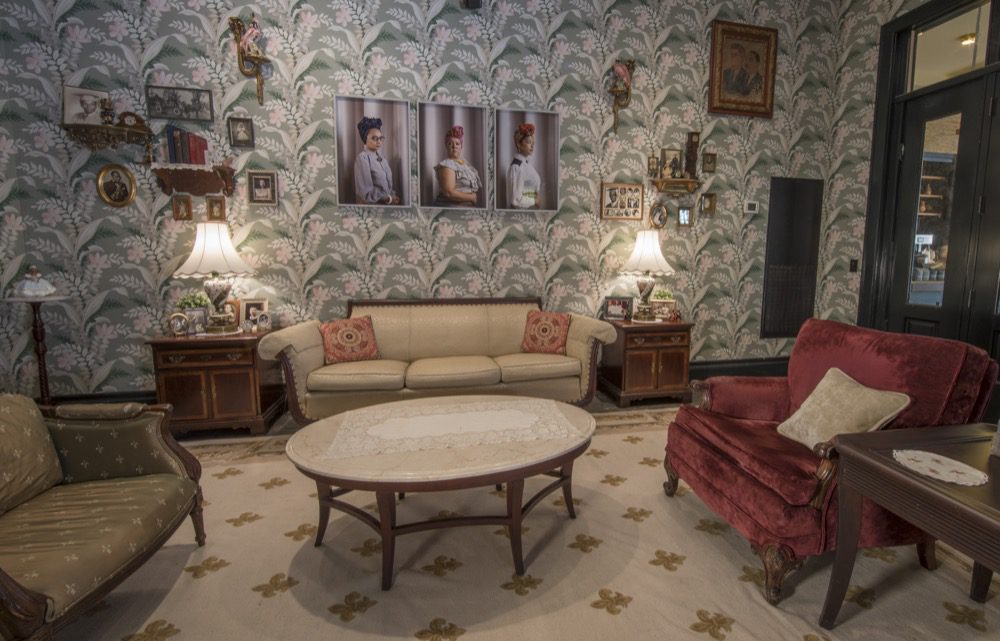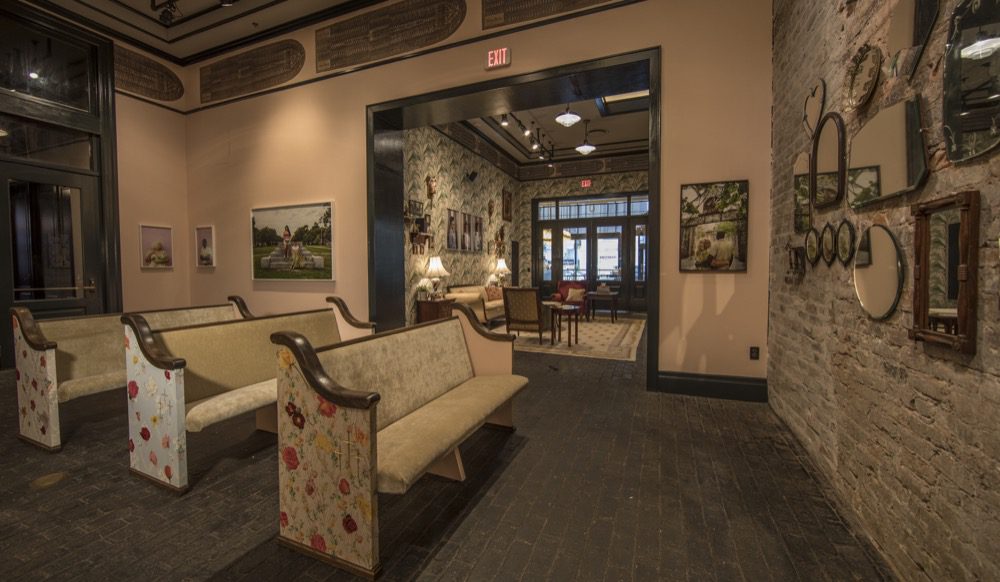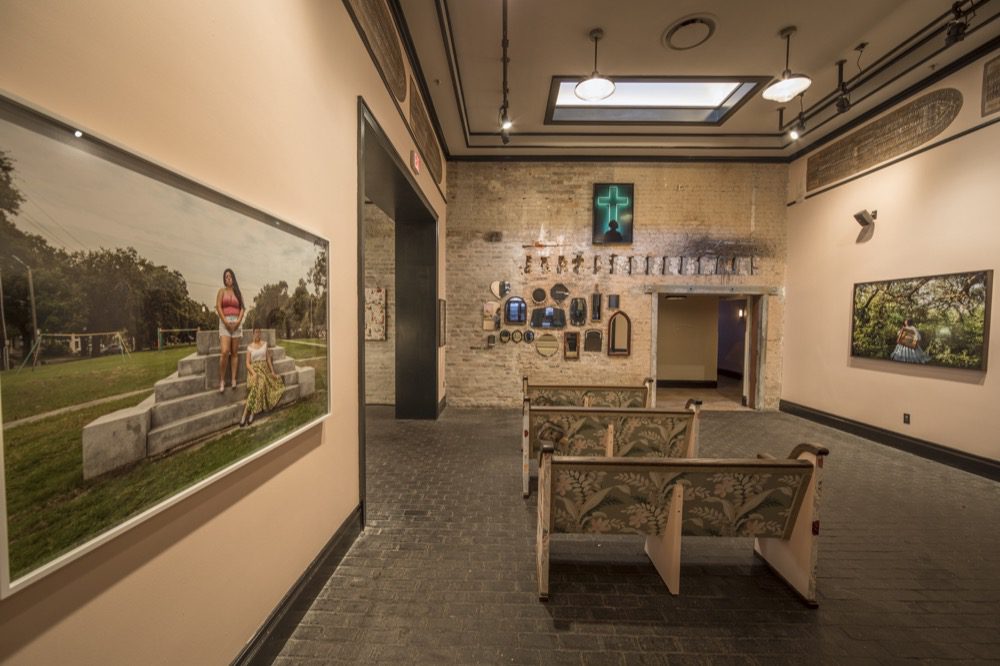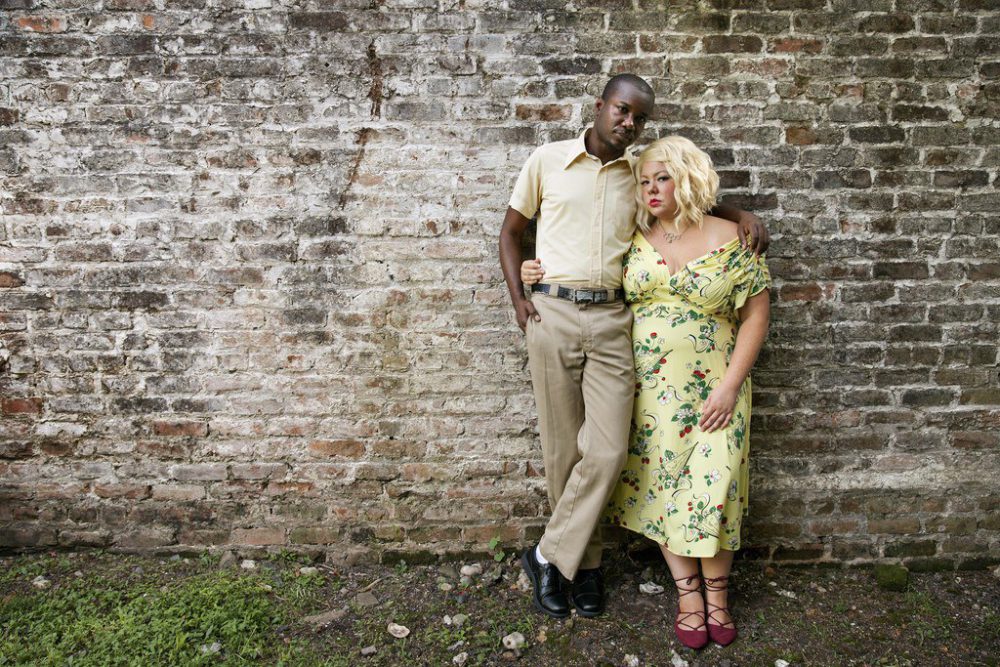Take a Closer Look: An Interview with Genevieve Gaignard
Cameron Shaw speaks with Genevieve Gaignard about her recent Prospect.4 installation, which transformed two rooms at Ace Hotel New Orleans.

Installation view of Genevieve Gaignard’s Grassroots, 2017, at Ace Hotel New Orleans. Courtesy the artist and Shulamit Nazarian, Los Angeles. Photo by Crista Rock.
Editor's Note
“Prospect.4: The Lotus in Spite of the Swamp” featured over 70 artists, but the work of Los Angeles-based Genevieve Gaignard has lingered in my mind. Gaignard uses self-portraiture and installation to examine the intersections of race, gender, and class and confront visitors’ stereotypes and assumptions.
For Prospect.4, she wholly transformed two rooms tucked behind the Ace Hotel’s Stumptown Coffee Roasters into works of art—one into a living room-like space, often filled with young professionals working on laptops or friends having drinks, and one into something that resembled a church, complete with pews and church fans. In both were staged photographs featuring Gaignard and others in situations and attire that resonate with New Orleans complicated legacies of slavery, creolization, and racial identification.
The works have a comforting familiarity, drawing on personal memories as well as a web of artistic associations that include Mickalene Thomas’ rec-room recreations and Cindy Sherman’s bodily plasticity—but they are also distinctly challenging, as Gaignard’s intended audience and message are not immediately understood. Before the installation came down, I spoke with Gaignard about family, her experience in New Orleans, and creating the work.
—Cameron Shaw
Cameron Shaw: Your father is from the Seventh Ward. Did this connection to New Orleans influence your approach to making work for Prospect.4?
Genevieve Gaignard: I knew once I was asked to participate in Prospect that my family roots in New Orleans would influence the work I wanted to make. Everything was photographed in New Orleans, not necessarily in the Seventh Ward. On one of the trips, I was just scouting locations and was able to trace the steps of my dad’s childhood. Seeing where he grew up and where different relatives grew up, I felt very connected to the city.
CS: Can you walk me through the parts of the installation?
GG: My installation pieces frequently are home settings. I knew I wanted the installation to feel super New Orleans but not clichéd, tourist New Orleans. I think that was the challenge. I had a visual of a parlor—maybe like a home that has been passed down a generation. You go into this space and it’s like the room at your grandparents’ house that you don’t go into—maybe you can go in, but you respect that space. You really wouldn’t mess with it and you might not even sit in it.
CS: I completely relate. I had the kind of grandparents that had plastic on the furniture because it was too good for us to sit on.
GG: If there’s anything that’s missing from the installation it’s probably that—the plastic on the furniture.
There are two large spaces at the Ace and I wanted to break it up, so it feels like a gallery but also so people could have a moment to sit and really think about things. In the pink room, there are several photographs on the walls but at the same time you’re invited to sit down at these church pews that were sourced locally. I wanted the viewer to be welcomed into this familiar place but have a moment to sit and reflect on the things that are being shown to them. At the very top of the walls, you’re seeing this image of a slave ship which is clearly a loaded image.

Installation view of Genevieve Gaignard’s Grassroots, 2017, at Ace Hotel New Orleans. Courtesy the artist and Shulamit Nazarian, Los Angeles. Photo by Crista Rock.
CS: I want to dive into that further. I visited the installation with several black women and there are things that were instantly familiar, like you said, this sense of being in your grandma’s house. Like that portrait of Martin Luther King Jr. and John F. Kennedy, my grandparents had that exact picture in their living room. I feel like lots of black kids of a certain age can remember their grandparents having that picture or something similar in their house. Then there are those things in the installation that are particularly disturbing like the interior view of the slave ship. The image repeats but it was mounted so high on the wall that, when I was visiting, the person I was with actually questioned whether it was part of the Ace’s design for the room rather than your installation.
How did you conceive of the audience for the installation or how they might react to it?
GG: Hanging out in the space and hearing all the different reactions, I heard very similar things to what you’re saying. But some people were into it, like, yes, that’s part of my story in terms of the history of slavery.
I was also thinking about how we come into spaces. Since the work is at the Ace, a lot of people don’t know that they are inside of an art installation. So there is this weird blur of Is this art? Is this here everyday? Is this just a cool hipster room? I think it really does depend on the individual’s story, what they want to see, and what they want to turn a blind eye to.
CS: Did the Ace factor into your thinking about the installation? I think they’ve done a lot of work to make it a useful and welcoming space for locals in terms of the restaurant, bar, and music venue, but, as a hotel, it’s fundamentally a tourist space. So you have people passing through who are engaging as much with the mythology of New Orleans as they are with the actual city. Did that influence your approach to thinking about how to use the space?
GG: I was aware that it’s a business, so dollar signs are what matter at the end of the day. People have to have a place to come in, have their beverage, spend some time and money. At the same time, while you’re sitting there and charging your phone or drinking your coffee, when you’re looking around, you get hit with some imagery that’s hopefully making you think.
One of the things that I heard repeatedly while sitting there was, “Whoa, I didn’t even see that.” In the first room, the parlor area, the imagery of the ship is slightly smaller and closer together, so it maybe reads as pattern at first. When you enter into the room with the pews, it’s meant for you to sit and contemplate, then you look up and at the characters in the photographs and figure out how these all connect to each other.

Installation view of Genevieve Gaignard’s Grassroots, 2017, at Ace Hotel New Orleans. Courtesy the artist and Shulamit Nazarian, Los Angeles. Photo by Crista Rock.
CS: I very much had that experience myself. There were little things I didn’t notice at first like the fleur-de-lis pattern on the carpet in the parlor area. And that moment of looking in the mirrors has the potential to transform your vision of what the installation is about. It’s a moment that complicates the question of what the installation is in a way that is really powerful.
How did you go about sourcing the materials? I’m thinking especially about the photographs of people in the living room-like setting. Are those people related to you?
GG: It is really a mix. Some of the pictures are my family’s photos. Others are found images from antique shops in the French Quarter, and some from a local shop called Material Life. I also used some from other people I know. In the triptych above the couch, the first woman is Terry Coleman. She dropped off pictures of her family, which I loved incorporating as well.
CS: Can you talk about the portraiture? Throughout the installation there are the photographs of you and another figure. The portrait areas are particularly complicated because of the ways in which you appear to be shifting identities. It’s reminiscent of Nikki S. Lee or Cindy Sherman but the gesture is even harder to read in part because of your own racial ambiguity. Why was it important for you to use your own body in the installation?
GG: I’m always using myself as the base. In all of my shows before, I was using myself solely, but there was something that happened when I was in New Orleans. I felt like I was being questioned less in terms of who I am, a woman of color. So that shifted how I approached making pictures in a way, welcoming the presence of others. There was a connection and understanding that I felt, as opposed to constantly feeling in my everyday life like I’m not seen.
CS: Can you talk about the content of those photographs? What are some of the stories or histories that you were attempting to capture with the portraits?
GG: A lot of times when I’m out photographing in the world, I’m not exactly clear on what I’m going for. I have to sit with the images and then things start to come out of it. In the triptych, I was referencing Tignon Law, which was a law that forced women of color to wrap their hair. So there’s a nod to this history, but it could also be present day.
I haven’t mentioned the gentleman that’s in some of the photographs with me. I met Sean through a Craigslist ad requesting a model to work with, which I had never done before.

Genevieve Gaignard, Front Line (Nothing to Hide), 2017. Chromogenic print. Courtesy the artist and Shulamit Nazarian, Los Angeles.
CS: Were you specific about your criteria for a model?
GG: Yes and no. I was looking for someone to complement the person I was portraying and when I saw a picture of Sean, I just felt like he was perfect for what I was going for.
CS: To be even more specific, was it important to you that it was a man? And was it important to you that it was a dark-skinned man?
GG: Yes, it was important that it was a man. And it was important that it was a black man. I wasn’t gauging how dark or light the model should be.
CS: But it does set up a particular dynamic between the two of you. The pairing of your two bodies calls attention to the issue of colorism or interracial histories.
GG: Right, exactly. I knew that would be the initial read. There’s also a more personal story, which is the story my father told me of my grandparents going out into the world and the comments said to them. My grandmother is really light, so she could pass, and it was assumed that she was white in some settings. If they were walking down the street together my grandfather was asked why he was walking with that white woman. So that was the thing I was thinking about when I initially wanted to cast someone to be in the photographs with me.
CS: And in thinking about how this series developed, did you intend for your body to be read as the same woman over and over again or as different women in each of the photographs? You change your hair, costumes, and other things. That’s something that really struck me—the play between sameness and difference in each of the photographs.
GG: I think it’s that constant back and forth. When does the viewer realize that it is the same person in all of the pictures? I consider them all different characters, but at the same time, reflecting facets of my own self and history.
Editor's Note
Genevieve Gaignard’s Grassroots, 2017, was on view November 18, 2017–February 25, 2018, at Ace Hotel New Orleans (600 Carondelet Street) as part of “Prospect.4: The Lotus in Spite of the Swamp.”



